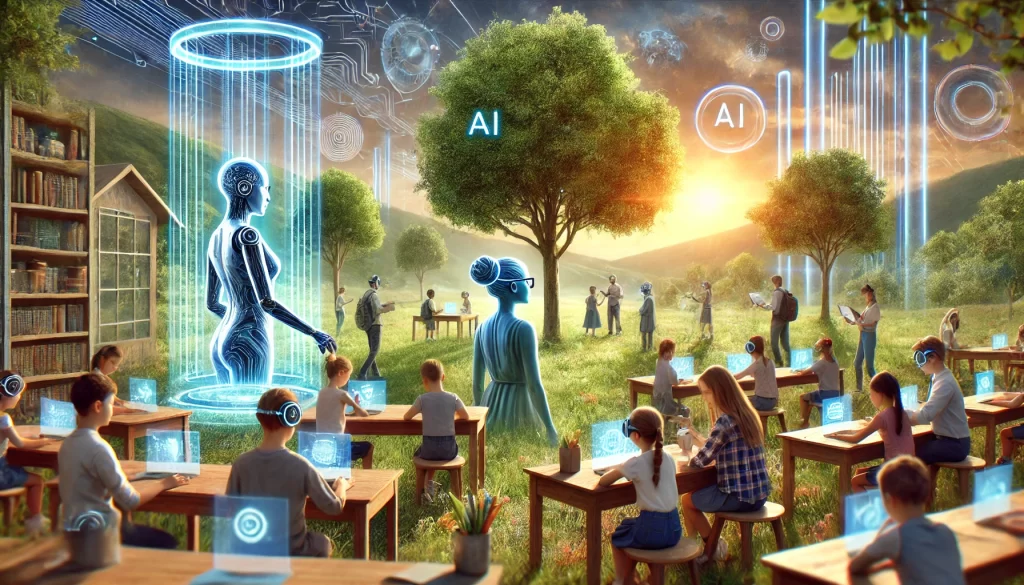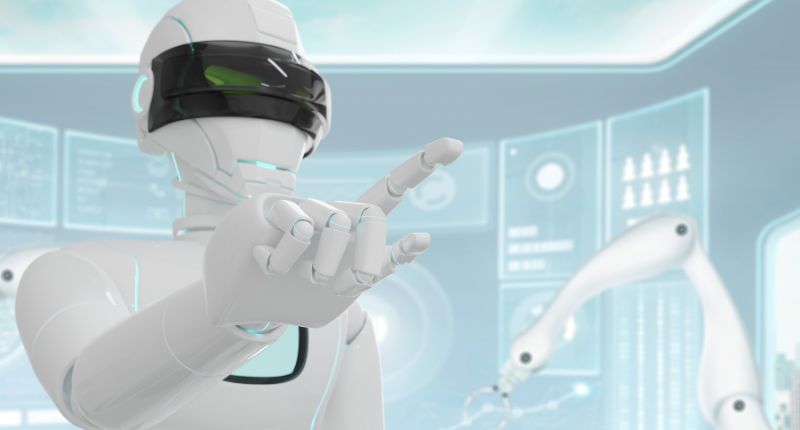Artificial Intelligence (AI) is revolutionizing various sectors, and education is no exception. The integration of AI into education promises to reshape how we learn, teach, and interact with educational content, transforming traditional classroom settings and extending the scope of educational opportunities. As AI continues to advance, its impact on education is bound to increase, bringing both challenges and opportunities. In this blog post, we’ll explore how AI will affect education in several key areas, including personalized learning, teacher support, administrative tasks, student engagement, and future job skills. Let’s see How Will AI Affect Education.
1. Personalized Learning: Tailoring Education to Individual Needs
One of the most significant ways AI is transforming education is through personalized learning. AI-powered tools can assess individual student performance and adapt to their learning styles, providing tailored learning experiences that suit their unique needs. Unlike traditional one-size-fits-all educational approaches, AI can adjust the difficulty level, pace, and content delivery based on the learner’s progress.
Adaptive Learning Systems
AI-driven adaptive learning systems are capable of analyzing vast amounts of student data, such as test scores, participation, and time spent on tasks, to deliver personalized content. For example, platforms like DreamBox, Knewton, and Smart Sparrow use AI to adjust lessons in real-time, enabling students to progress at their own pace. These systems can identify gaps in understanding and provide supplementary resources, such as videos, quizzes, and additional exercises, to help students master the material.
Learning Pathways
AI can also design personalized learning pathways that consider a student’s strengths, weaknesses, and interests. By analyzing historical data and behavioral patterns, AI systems can recommend specific courses or learning modules that align with a student’s goals, enhancing motivation and engagement. This level of personalization empowers students to take control of their learning journey, promoting lifelong learning and self-directed education.
2. AI as a Teacher Support Tool: Enhancing Educators’ Effectiveness
While AI is often discussed in the context of replacing teachers, its true potential lies in enhancing the role of educators. Teachers are essential in providing emotional support, fostering social development, and guiding students through complex learning processes. AI can act as an invaluable assistant, helping educators focus on these higher-level tasks while automating routine, time-consuming aspects of teaching.
Automating Administrative Tasks
AI can automate many administrative tasks that take up a significant portion of a teacher’s time, such as grading assignments, tracking attendance, and managing schedules. Tools like Gradescope and Turnitin use AI to grade assignments and provide feedback, saving teachers hours of work. With AI handling these repetitive tasks, teachers can dedicate more time to interacting with students, offering personalized support, and improving the quality of instruction.
AI-Powered Lesson Planning and Content Creation
AI can assist educators in planning lessons by suggesting resources, generating lesson plans, and providing content that aligns with curriculum standards. For example, platforms like ScribeSense use AI to create customized worksheets and quizzes, ensuring that lessons are dynamic and engaging. This enables teachers to quickly prepare high-quality content without spending excessive time on manual preparation.
Teacher Analytics
AI can also provide teachers with valuable insights into how students are performing. By tracking students’ progress, understanding their learning behaviors, and analyzing patterns, AI systems can give teachers a comprehensive view of class performance. This data allows educators to intervene early if a student is struggling or to modify the lesson plan if a particular teaching method isn’t effective.
3. AI and Student Engagement: Making Learning More Interactive
AI has the potential to make learning more engaging and interactive, ultimately improving student outcomes. By incorporating AI-driven tools and platforms into the classroom, educators can create an immersive and collaborative learning environment that fosters deeper engagement.
Virtual Tutors and Chatbots
AI-powered virtual tutors and chatbots can provide students with immediate assistance, answering questions and offering explanations on demand. These virtual assistants can interact with students in a conversational manner, guiding them through exercises, quizzes, and assignments. For example, chatbots like IBM Watson can engage students in real-time discussions and provide instant feedback, helping students better understand complex concepts.
Gamification and AI
Gamification, where educational content is delivered through game-like experiences, is another way AI can improve student engagement. AI systems can analyze a student’s progress and adapt the difficulty level of the game to keep them challenged but not frustrated. This dynamic approach to learning increases motivation, as students are more likely to stay engaged in the material when it feels like a fun, interactive experience rather than a traditional lecture.
Augmented and Virtual Reality (AR/VR)
AR and VR technologies, powered by AI, are transforming the way students interact with content. These technologies provide immersive experiences where students can interact with 3D models, simulations, and virtual environments that bring abstract concepts to life. For instance, in subjects like biology, AI-powered AR and VR tools can allow students to explore the human body in 3D, deepening their understanding of complex structures and systems.
4. AI in Administrative Tasks: Streamlining Operations
AI is not only transforming teaching and learning but also revolutionizing the administrative functions of educational institutions. From managing student data to optimizing resource allocation, AI can streamline various administrative tasks, making operations more efficient and cost-effective.
Student Admissions and Enrollment
AI can simplify the admissions process by automating tasks such as processing applications, reviewing student records, and analyzing application data. For example, AI systems can assess whether applicants meet specific criteria, assign them to appropriate programs, and even predict whether a student will succeed in a particular course or program. AI can also help institutions better match students to the programs that best suit their skills and interests.
Data-Driven Decision Making
AI can assist educational administrators in making data-driven decisions by analyzing large datasets related to student performance, behavior, and enrollment trends. By using predictive analytics, administrators can forecast future enrollment numbers, identify at-risk students, and allocate resources more effectively. This allows educational institutions to make proactive decisions that improve student retention and academic success.
Learning Management Systems (LMS)
AI-integrated learning management systems, like Moodle or Canvas, can enhance the teaching and learning experience by providing advanced features such as predictive analytics, personalized learning recommendations, and real-time reporting. These systems help both students and educators stay on track, ensuring that learning objectives are met efficiently.
5. AI and the Future of Job Skills: Preparing Students for the Workforce
As AI continues to evolve, it will reshape the job market, creating new career opportunities while making some existing jobs obsolete. The integration of AI into education will be crucial in preparing students for this new job landscape. Educational institutions must adapt curricula to equip students with the skills needed to thrive in an AI-driven economy.
Teaching AI and Data Literacy
One of the most important skills that students will need in the future is the ability to work with AI and data. Educational institutions must incorporate AI and data literacy into their curricula to ensure that students can understand, analyze, and apply AI technologies in various fields. This includes teaching coding, machine learning, data analysis, and algorithmic thinking from an early age, ensuring that future workers can work alongside AI systems.
Soft Skills and Emotional Intelligence
While AI will play an increasingly central role in the workforce, there are certain skills that machines cannot replicate, such as creativity, emotional intelligence, and critical thinking. These “soft skills” will become increasingly important as AI takes over more routine and technical tasks. Educational systems must focus on developing these non-technical skills, ensuring that students are prepared for jobs that require human insight and empathy.
Collaboration with AI
Rather than fearing AI, students will need to learn how to collaborate with AI technologies to enhance their work output. This includes understanding how to use AI tools to improve productivity, creativity, and problem-solving skills. In fields like healthcare, finance, and engineering, professionals will need to work alongside AI systems to analyze data, make decisions, and innovate. Educational programs will need to emphasize this collaborative mindset, ensuring that students are comfortable with AI as a tool rather than viewing it as a competitor.
6. Ethical Considerations and Challenges of AI in Education
While AI offers many opportunities to enhance education, there are also significant challenges and ethical considerations that must be addressed. The widespread adoption of AI in education raises concerns about privacy, security, and bias, which could have profound implications for students and educators.
Privacy and Data Security
AI in education relies heavily on student data to provide personalized learning experiences. This raises concerns about data privacy and security, as sensitive information such as academic records, personal preferences, and behavioral data is collected and analyzed. Educational institutions must take steps to ensure that this data is protected and used ethically, with transparent consent processes and strong security measures in place.
Bias and Fairness
AI systems are only as good as the data they are trained on, and if this data is biased, the AI system may perpetuate those biases. For example, if an AI system is trained on data from a particular demographic, it may not perform equally well for students from different backgrounds. This is especially concerning in education, where AI systems can influence student outcomes. Developers and educators must work to ensure that AI systems are fair, unbiased, and inclusive.
Teacher-Student Relationship
Another concern is the potential for AI to erode the human element of education. Teachers play a critical role in building relationships with students, providing emotional support, and fostering social development. While AI can enhance educational experiences, it cannot replace the personal connection and mentorship that teachers offer. Educators must find ways to integrate AI tools in a way that complements, rather than replaces, the teacher-student relationship.
7. The Role of AI in Lifelong Learning and Continuing Education
In addition to K-12 and higher education, AI is poised to revolutionize lifelong learning and continuing education. As industries evolve and new technologies emerge, workers must constantly upskill and adapt. Traditional educational systems are often not agile enough to keep up with the rapid pace of change, but AI offers a solution by enabling personalized, on-demand learning for individuals throughout their lives.
On-Demand Learning Platforms
AI-powered learning platforms like Coursera, LinkedIn Learning, and Duolingo are making it easier for individuals to learn new skills on their own terms. These platforms use AI algorithms to recommend courses based on a learner’s current skill set, interests, and career goals. By providing personalized learning suggestions and tracking progress over time, these platforms empower individuals to take control of their education and pursue lifelong learning.
Microlearning and Just-in-Time Training
AI enables the rise of microlearning, which delivers content in small, digestible chunks. This approach is ideal for adult learners who need to acquire specific skills quickly without committing to long courses. AI can analyze the learner’s needs and serve up bite-sized, relevant content just when it’s needed. For example, an employee may use an AI-powered platform to quickly acquire a specific skill, such as learning to use a new software tool or understanding a regulatory update. This flexibility makes lifelong learning more accessible and efficient.
Workplace Learning
AI is also transforming workplace learning by enabling organizations to offer tailored training experiences to employees. AI can track individual employee progress, recommend courses, and even predict future skill gaps. Companies can use AI to create customized learning paths for employees, ensuring that they remain competitive in the job market. Moreover, AI can be used to offer real-time feedback and coaching, allowing employees to continuously improve their skills as they work.
8. AI’s Impact on Global Education Equity
One of the most exciting prospects of AI in education is its potential to reduce educational disparities and improve access to quality learning for students in underserved regions of the world. In many areas, access to quality education is limited by factors such as geography, socioeconomic status, and lack of qualified teachers. AI can help bridge these gaps by providing affordable, high-quality learning experiences.
Access to Quality Resources
With AI-powered education platforms, students in remote or underserved areas can access world-class educational resources at little to no cost. Platforms like Khan Academy and Coursera offer free or low-cost lessons on a variety of subjects, making quality education more accessible. AI can further enhance these platforms by providing personalized feedback and adapting content to the learner’s level. This opens up opportunities for students who may have otherwise been excluded from traditional education systems due to financial or geographical constraints.
Language Barriers and AI Translation
Another way AI can address educational equity is by breaking down language barriers. AI-powered translation tools, like Google Translate, are becoming increasingly sophisticated, enabling students to access learning materials in their native language. This is especially important for students in multilingual regions or those who speak less commonly taught languages. By providing real-time translations of textbooks, lectures, and assignments, AI can ensure that language is no longer a barrier to quality education.
Remote and Hybrid Learning
The COVID-19 pandemic accelerated the shift to remote and hybrid learning, and AI is playing a crucial role in making these models more effective. AI tools can enhance online learning platforms by making them more interactive and engaging. Virtual classrooms powered by AI can simulate traditional learning environments, providing students with opportunities to collaborate and interact with peers and instructors. This shift helps provide access to education for students who may not have been able to attend physical schools due to distance, disability, or other challenges.
9. The Potential for AI in Special Education
AI’s potential to support students with special needs is another exciting development in the education space. By offering tailored learning experiences and real-time feedback, AI can make education more inclusive for students with disabilities and learning challenges.
Personalized Learning for Students with Disabilities
AI can help create customized educational experiences for students with learning disabilities like dyslexia, ADHD, or autism. Adaptive learning systems can adjust content delivery based on the student’s abilities and provide additional support when needed. For example, AI tools can read text aloud for students with dyslexia or provide visual aids for students with autism, helping them engage with the material in a way that suits their learning style.
Assistive Technologies
AI-powered assistive technologies, such as speech-to-text tools, text-to-speech readers, and real-time captioning, can make learning more accessible for students with physical disabilities. For example, AI-powered speech recognition can help students with mobility impairments or motor difficulties complete assignments without needing a keyboard. AI can also provide real-time captions for students who are deaf or hard of hearing, ensuring that all students can engage with course material regardless of their physical limitations.
Social and Emotional Support
AI can also provide social and emotional support for students with special needs. For example, AI-driven virtual companions or chatbots can offer students a safe space to express themselves and receive encouragement. These tools can help students with social anxiety, autism, or other conditions that make it challenging to interact with peers or educators. By providing a non-judgmental, supportive environment, AI tools can help these students feel more confident and empowered in their learning journey.
10. The Long-Term Outlook: Challenges, Opportunities, and the Role of Teachers
While the benefits of AI in education are clear, it is also important to consider the long-term implications and challenges of widespread AI adoption. As AI continues to evolve, there will be ongoing debates about its role in education, particularly in terms of its impact on teachers and the broader educational ecosystem.
The Need for Teacher Training
For AI to be effectively integrated into education, educators must be adequately trained to use AI tools and integrate them into their teaching practices. This includes understanding how AI works, how it can support students, and how to address ethical concerns related to AI use. Teacher training programs will need to be updated to include AI literacy, ensuring that teachers are prepared to use these technologies effectively.
The Role of Human Connection
Despite its many benefits, AI cannot replace the human connection between teachers and students. Teachers provide emotional support, mentorship, and social guidance that AI tools cannot replicate. The future of education should focus on how to use AI to enhance, rather than replace, the role of teachers. AI can take on repetitive tasks, provide personalized learning experiences, and offer real-time feedback, but it will always be up to educators to inspire, motivate, and nurture students.
Preparing for a Future with AI
The rapid pace of technological change means that educational systems must be agile and adaptable. As AI continues to evolve, educational institutions will need to constantly reassess their curricula to ensure that students are acquiring the skills needed to succeed in an AI-driven world. This will require collaboration between educators, policymakers, and technology developers to create a future where AI is used to augment human potential, not replace it.
Conclusion
AI is transforming education in profound ways, offering opportunities to personalize learning, support educators, engage students, and enhance accessibility. As we look toward the future, AI will continue to play a critical role in reshaping how we learn, teach, and interact with educational content. While there are challenges to overcome, such as ensuring equity, addressing ethical concerns, and preserving the human element of teaching, the potential benefits of AI in education are undeniable.
By embracing AI responsibly and integrating it thoughtfully into educational systems, we can create a more personalized, inclusive, and effective learning environment for students worldwide. The future of education is undoubtedly intertwined with AI, and those who are prepared to harness its potential will shape the next generation of learners, workers, and leaders.
Curious about the future of jobs in an AI-driven world? Check out our article on Will AI Replace Jobs? Best Understanding Its Role to explore how AI is transforming the workforce and its potential impact on employment.


